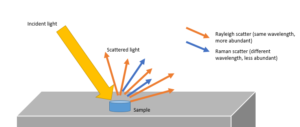In News: IIT Madras have demonstrated that by using Raman thermometry on fibre optic cables, they can achieve the monitoring of power transmission cables.
Raman Thermometry
- Raman spectroscopy analytical method for identifying chemical compounds and characterizing the chemical bonding and solid-state structure of materials.
- One can use Raman spectroscopy to determine the temperature of the material being analyzed.
- Raman thermometry is a thermal characterization technique which makes use of Raman scattering phenomena to determine the local temperature in microelectronics systems.
- When light is scattered off an object, say a molecule, two bands are observed, with higher and lower frequency than the original light, called the Stokes and anti-Stokes bands, respectively.

IIT Madras achievement
- The temperature measurement was performed in not just one location, but in a distributed manner using an optical fibre.
- To achieve this, a pulse of light was launched into the optical fibre and the backscattered radiation was observed.
- The time of flight of the backscattered radiation provided an estimate of the distance from which the light is backscattered.
- This can go up to tens of kilometres. This technique is married to Raman thermometry to get the results for actual measurements over tens of kilometres.
Why experiment special?
- Transmission and Distribution loss that is incurred to our DISCOMS.
- This technology helps analyze transmission efficiencies in a better way.
Raman Effect
- The Raman Effect is a phenomenon in spectroscopy discovered by the eminent physicist Sir Chandrasekhara Venkata Raman in 1928.
- In 1930, he got a Nobel Prize for this remark.
- The Raman Effect is a change in the wavelength of light that occurs when a light beam is deflected by molecules.
Observing the effect

- The Raman Effect is when the change in the energy of the light is affected by the vibrations of the molecule or material under observation, leading to a change in its wavelength.
- Raman effect is “very weak” — this is because when the object in question is small (smaller than a few nanometres), the light will pass through it undisturbed.
- But a few times in a billion, light waves may interact with the particle. This could also explain why it was not discovered before.
- In general, when light interacts with an object, it can either be reflected, refracted or transmitted.
- One of the things that scientists look at when light is scattered is if the particle it interacts with is able to change its energy.















